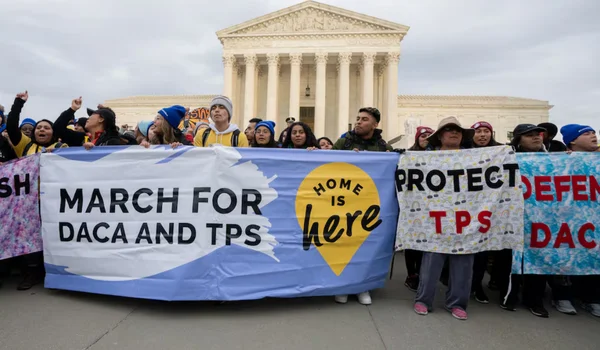TPS, DACA and asylum programs provide crucial legal protections for hundreds of thousands of Latino immigrants in the United States. In 2025, ongoing updates to these programs are creating significant changes that could affect work permits, family stability, and legal status for immigrants from countries like Haiti, Venezuela, El Salvador, and more.
According to the Department of Homeland Security (DHS), over 320,000 individuals currently hold TPS from Haiti and Venezuela alone, while USCIS reports that thousands of DACA recipients are due for renewals this year.
For Latino families, staying informed about these updates is critical—not only to maintain employment and educational opportunities, but also to protect family unity and plan for long-term immigration stability.
This guide explains the latest 2025 TPS, DACA and asylum updates, provides practical advice, and outlines clear steps families can take to safeguard their rights and future in the United States.
What is TPS, and how do the 2025 updates affect families?

Temporary Protected Status (TPS) is a humanitarian program established by the U.S. government that allows immigrants from countries experiencing conflict, natural disasters, or extraordinary conditions to live and work in the United States legally for a limited period.
TPS is intended to provide temporary relief and protection from deportation while the situation in the immigrant’s home country prevents safe return.
2025 Updates for TPS:
The latest updates in 2025 focus on Haiti and Venezuela, two countries whose TPS designations are under review due to political instability, natural disasters, and economic crises.
The U.S. Department of Homeland Security (DHS) has indicated that TPS may be extended for certain groups, while termination notices have already been issued for others, creating uncertainty for families dependent on TPS for legal status and employment.
Key statistics:
- According to DHS, over 320,000 TPS holders are currently from Haiti and Venezuela combined (DHS, 2024).
- USCIS data indicates that nearly 50,000 Venezuelans in the U.S. face uncertainty due to TPS termination notices (USCIS, 2024).
- Approximately 60% of TPS holders are heads of households, meaning that TPS decisions directly affect entire families (Pew Research Center, 2023).
Practical implications for families:
If TPS ends for a particular country, affected individuals risk losing their work authorization and legal status, which can disrupt employment, education, and access to essential services. Families must be aware that TPS termination does not automatically grant alternative legal status, so proactive planning is critical.
Families should consider several legal pathways to maintain protection and stability, including:
- Adjustment of Status (AOS): For those eligible, adjusting to permanent residency through family sponsorship or employment-based petitions may be an option.
- Asylum claims: Immigrants from countries facing persecution, violence, or humanitarian crises may qualify for asylum. Filing for asylum before TPS expiration ensures continued legal protection and potential work authorization.
- Humanitarian visas or parole programs: Certain emergency situations may qualify family members for temporary protection or special parole programs to remain in the U.S. legally.
According to the Migration Policy Institute (MPI), “Early planning for TPS termination is critical for families to avoid status loss and ensure continuity of employment and benefits. Legal counsel can guide TPS holders through alternative pathways to remain in the U.S. legally.”
In short, understanding the 2025 TPS updates is essential for immigrant families to protect legal status, employment, and family unity. Exploring family immigration options, including asylum claims and adjustment of status, can provide stability during this period of uncertainty.
For guidance on TPS and related immigration options, legal resources provide consultations and detailed case analysis.
How do DACA renewals and first-time applications change in 2025?
Deferred Action for Childhood Arrivals (DACA) allows eligible immigrants who arrived as children to receive temporary protection from deportation and a work permit.
2025 updates include:
- Streamlined renewal process for current DACA holders.
- Expanded eligibility review for first-time applicants who meet educational and residency requirements.
- Affected individuals must track the 180-day clock, which starts when USCIS receives their application.
Practical advice:
- Always submit renewal applications at least 120 days before expiration.
- Keep updated documentation of school enrollment or employment to strengthen your application.
Case example: Carlos, age 23, arrived in the U.S. at age 5. His DACA renewal is due in April 2025. Applying early ensures he retains his work permit and continues attending college without disruption.
Insight from USCIS: “DACA renewals help stabilize mixed-status families by maintaining employment and education continuity while ensuring compliance with federal law.”
Mixed-status families—where some members have DACA and others do not—should carefully plan to maintain family unity and legal protections.
What are the main asylum rule changes at the U.S. border in 2025?
Asylum laws continue to evolve, affecting eligibility, processing times, and work authorization.
Key updates for 2025:
- DHS has clarified criteria for credible fear interviews and expedited removal exceptions.
- New guidance affects the work permit after asylum process: applicants can now request employment authorization after 150 days, instead of the previous 180.
- Border enforcement and local USCIS offices are prioritizing family-based asylum cases.
Practical steps for applicants:
- File asylum claims promptly to benefit from the reduced wait for work authorization.
- Keep thorough documentation of persecution or threats in your home country.
- Consult attorneys familiar with asylum law to prevent denials due to procedural errors.
What happens if TPS ends for countries like Haiti or Venezuela?
When TPS ends, affected immigrants face multiple challenges: potential loss of legal status, employment, and access to public services. The government may provide a “grace period,” but it varies by country.
Legal considerations:
- Evaluate eligibility for asylum, family-based petitions, or humanitarian parole.
- Prepare to adjust your immigration strategy before TPS expiration.
Pew Research Center notes that over 60 % of TPS holders are heads of households, meaning termination could affect entire families.
How does DACA affect mixed-status families?
DACA provides protections that indirectly benefit family members with different immigration statuses.
Important points:
- DACA recipients can sponsor family members only under limited circumstances, but maintaining legal work and residence supports family stability.
- Loss of DACA can trigger risks for children and spouses if family-based options are not in place.
Example: Ana’s older sibling has DACA, but her younger brother does not. If DACA is renewed, Ana’s family can continue receiving financial and educational support through work permits, helping maintain stability despite mixed immigration statuses.
How does the 180-day clock work for DACA and asylum applicants?
The 180-day clock determines eligibility for certain immigration benefits, including work permits.
Key points:
- For DACA, the clock starts once USCIS receives a renewal or first-time application.
- For asylum, the clock tracks how long an applicant waits before requesting employment authorization.
- Missing deadlines can delay legal work status and affect family stability.
What are family immigration options after TPS ends?
Families facing TPS termination can explore several avenues:
- Asylum claims for individuals at risk of persecution in their home country.
- Family petitions to adjust status through U.S. citizen or permanent resident relatives.
- Humanitarian visas or parole programs for urgent cases.
Consult immigration attorneys to analyze eligibility and deadlines. Proactive planning prevents loss of legal status and work authorization.
What should you do if your asylum or DACA application is delayed?
Delays can create significant stress for families. Here’s what to do:
- Monitor USCIS case status online regularly.
- Document all communications and receipts.
- Consider filing a service request or seeking attorney assistance if processing exceeds normal timelines.
How can legal professionals help Latino families navigate these changes?
Immigration law can be complex, but legal assistance ensures families protect their rights. Experienced attorneys can:
- Review eligibility for TPS, DACA, or asylum.
- File timely applications and renewals.
- Guide families through work authorization processes.
- Advise on mixed-status family planning.
Expert insight: “Early legal consultation significantly reduces the risk of status loss and financial instability for families affected by TPS or DACA updates,” – American Immigration Lawyers Association (AILA).
Contact a qualified immigration attorney or schedule a consultation to secure guidance tailored to your family’s situation.
Protecting Your Family Amid 2025 Immigration Updates
The 2025 changes to TPS, DACA, and asylum rules present both challenges and opportunities for Latino families in the U.S. Understanding deadlines, work permit eligibility, and family immigration options is crucial.
Key takeaways:
- TPS termination for countries like Haiti or Venezuela requires immediate legal assessment.
- DACA renewals and first-time applications must consider the 180-day clock.
- Asylum applicants should track work permit eligibility and document all supporting evidence.
- Mixed-status families benefit from careful planning and early legal support.
Staying informed about TPS, DACA and asylum, documenting your case, and seeking professional legal guidance are the best ways to protect your family’s future. Schedule a consultation with an immigration attorney today to understand your options and secure peace of mind.


 Oliver Johnson is LawScroller’s Senior Legal Correspondent specializing in civil litigation, class actions, and consumer lawsuit coverage. He breaks down complex settlements and court decisions into clear, practical guidance for readers.
Oliver Johnson is LawScroller’s Senior Legal Correspondent specializing in civil litigation, class actions, and consumer lawsuit coverage. He breaks down complex settlements and court decisions into clear, practical guidance for readers.